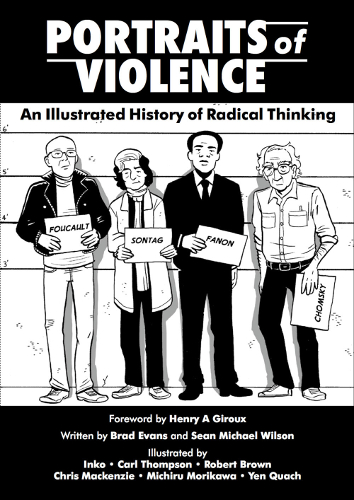 Sean Michael Wilson’s latest non-fiction comic book – written in conjunction with the political philosopher Brad Evans – surveys a wide variety of thinking about violence, by 10 figures from the 20th and 21st centuries, ranging from Hannah Arendt and Franz Fanon to Judith Butler and Noam Chomsky.
Sean Michael Wilson’s latest non-fiction comic book – written in conjunction with the political philosopher Brad Evans – surveys a wide variety of thinking about violence, by 10 figures from the 20th and 21st centuries, ranging from Hannah Arendt and Franz Fanon to Judith Butler and Noam Chomsky.
Unfortunately, most of the treatments are – perhaps necessarily, given their brevity – fairly superficial. I suspect that some of the showcased thinkers (for example Judith Butler) have little of value to offer.
There are a few interesting nuggets here and there. To take two examples: John Gray’s intriguing remark that ‘prominent Enlightenment figures favored violence as an instrument of social transformation’, and the revelation that US president Dwight D Eisenhower originally included the word ‘academic’ in his famous 1961 coinage ‘the military-industrial-complex’. Unfortunately, these are few and far between. Intelligibility is a serious problem.
Thus, after reading the section on the Brazilian educator Paulo Freire, you could be forgiven for being none the wiser as to what Freire meant by education as ‘the practice of freedom’. Likewise, the definition of ‘bio-power’ in the jargon-dense section on the French philosopher Michel Foucault was unintelligible to me. Then again, Foucault once told the US philosopher John Searle: ‘If I wrote as clearly as you do people in Paris wouldn’t take me seriously. They’d think it’s childlike... In France, you’ve got to have 10 percent incomprehensible’.
There are a couple of criticisms, not in any depth, of Steven Pinker’s monumental book The Better Angels of Our Nature, which draws on a huge body of evidence to argue that ‘violence has declined over long stretches of time’ (on scales from millennia to years) and that ‘today we may be living in the most peaceable era in our species’ existence’.
Several of the book’s intelligible claims struck me as unconvincing. For example, Evans’ ‘more subtle reading’ of the Afro-Caribbean revolutionary Frantz Fanon, which he claims supports nonviolence. Or Susan Sontag’s assertion that the current ‘appetite for pictures showing bodies in pain’ is ‘as keen, almost, as the desire for ones that show bodies naked’. (I suspect that a survey of internet content would suggest otherwise.)
Disappointing.
Topics: Violence & nonviolence


